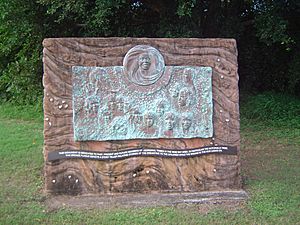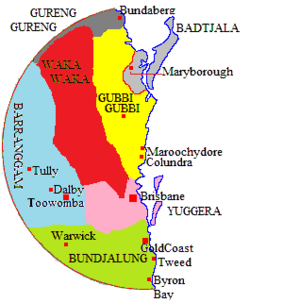Butchulla facts for kids

The Butchulla people are an Aboriginal Australian group. They traditionally lived on K'gari (which is now called K'gari) in Queensland, Australia. They also lived on a small part of the mainland nearby. You might also see their name spelled as Butchella, Badjala, Badjula, Badjela, Bajellah, Badtjala, or Budjilla.
Contents
What Language Did the Butchulla Speak?
The Butchulla people spoke a language called Badjala. This language was a dialect of the larger Gubbi Gubbi language. Other groups on K'gari also spoke different Gubbi Gubbi dialects. The name "Butchulla" might mean "sea folk," referring to their connection to the ocean.
In the 1800s, there were about 19 different groups living on K'gari. The island was divided into three main areas. The people in the northern part of the island, called the Ngulungbara, were a separate group. The Dulingbara people lived in the southern part of the island. They also moved along the coast towards the Noosa area. All three groups—Ngulungbara, Butchulla, and Dulingbarra—spoke different versions of the Gubbi Gubbi language. The Batjala language was spoken around Hervey Bay, inland towards Maryborough, and on K'gari.
Where Did the Butchulla Live?
The Butchulla people's traditional lands were mainly in the middle of K'gari. Their territory also stretched over 1,700 square miles (4,400 square kilometres) to the mainland coast. This area was south of Noosa. The Butchulla travelled to the mainland through the lower parts of Tinana Creek. Their land went north to Pialba in Hervey Bay. To the west, their borders followed the upper Mary River.
The lands of the Butchulla, Gubbi Gubbi, and Dulingbara groups sometimes met at Mount Bauple. Around 20 years after Europeans arrived, it was thought that about 2,000 people lived on K'gari. This large number suggests that the island had plenty of food resources. It was one of the most populated areas in Australia before European contact.
How Were Butchulla Communities Organised?
K'gari was rich in fish and other food sources. This made it one of the most populated places in Australia. The people of K'gari were generally divided into three main groups: Ngulungbara, Butchulla, and Dulingbara. Each of these groups had several smaller clan groups. Together, they formed 19 subgroups.
The Ngulungbara lived in the northern part of the island. The Butchulla, in the strictest sense, lived in the middle. The Dulingbara lived in the south. The Dulingbara and Ngulungbara groups considered themselves distinct.
A Brief History of Contact with Europeans
Archaeological findings suggest that people might have visited the island long ago. A lead weight found on the island, containing a type of pumice, indicates it could have arrived between 1410 and 1630 CE. This was even before Ferdinand Magellan sailed around the world.
Matthew Flinders was the first European to land on K'gari. He arrived at Bool Creek in July 1802 and briefly met the Ngulungbara group. In 1836, survivors from a shipwreck, the Stirling Castle, landed on the island. Eliza Fraser, the captain's wife, lived among the local islanders for several weeks.
Europeans began to settle on the island in 1849. At that time, the Indigenous population of the 19 clans was estimated to be around 2,000 people. However, within 30 years (by 1879), their numbers had fallen to about 300–400. This decline was partly due to shootings by the Australian native police.
Many of the remaining Butchulla people were moved to Yarrabah around 1902. Later, they were moved to Barambah station.
What is Native Title for the Butchulla People?
In 2014, an Australian Federal Court officially recognised the Native title rights of the Butchulla people over K'gari. This means the Butchulla people have special rights to their traditional lands and waters.
Other Names for the Butchulla People


